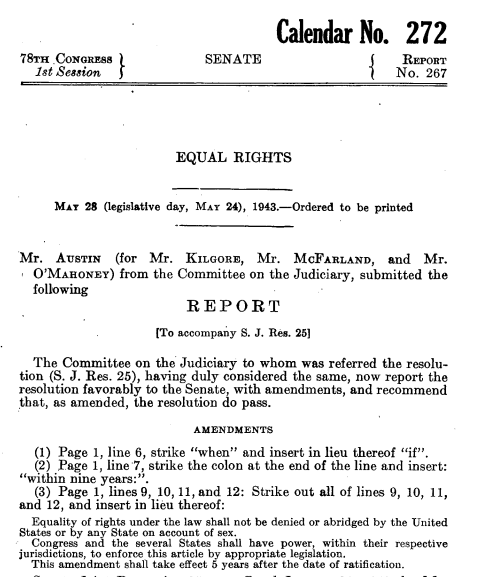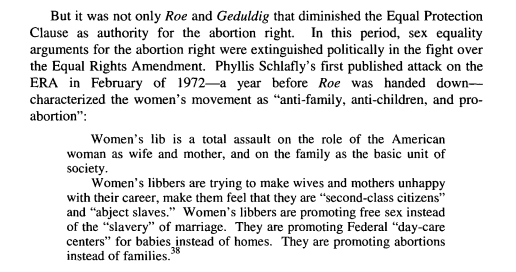Are men and women seen as equal under the law in 2022 America? Women have the right to vote and to equal wages, and there are more women in power than ever before. And sex discrimination has been tackled in various federal and state laws over the years. However, the United States Constitution[1]Henry H.; Jefferson Smith, Thomas. Constitution of the United States of America, with the Amendments Thereto; to Which are Added Jefferson’s Manual of Parliamentary Practice (3). This document is located in HeinOnline’s World … Continue reading does not yet recognize equality on the basis of sex. The Equal Rights Amendment (ERA) would change that, making sure that women’s basic rights are forever protected. However, despite the fact that it was written nearly 100 years ago, the ERA has not yet been ratified.
Join us as we use the extensive resources within HeinOnline, including our Women and the Law (Peggy) and U.S. Congressional Documents databases, to explore the history of the ERA and where it stands today—just in time for Women’s History Month.
The Origins of the ERA
The ERA was first drafted in 1923 by National Women’s political party members Alice Paul and Crystal Eastman. After gaining the right to vote with the 19th Amendment,[2]Declaration of Independence and the Constitution of the United States of America (1934). This document is located in HeinOnline’s World Constitutions Illustrated database. suffragists wanted to ensure that all of their rights would be protected by the Constitution. The amendment read: “Men and women shall have equal rights throughout the United States and every place subject to its jurisdiction.”[3]65 Cong. Rec. 106 (1923). This document is located in HeinOnline’s U.S. Congressional Documents database.

Supporters of the ERA proposed the amendment at every Congressional session from 1923 until 1943, at which time Alice Paul put forth a revised amendment which mimicked wording from the 5th and 14th amendments: “Equality of rights under the law shall not be denied or abridged by the United States or by any State on account of sex.”[4]“Proposing amendment to Constitution of United States granting equal rights to men and women.” U.S. Congressional Serial Set, , 1943, p. 1-4. HeinOnline, … Continue reading This updated version was then proposed at every Congressional session until 1972.

Support in Congress
The rise of second-wave feminism in the late 1960s stirred newfound public support for the ERA. The National Organization of Women (NOW) held demonstrations at the Capitol to fight for the amendment’s passage (see photo below[5]Doris L. Sassower, Women and the Judiciary: Undoing the Law of the Creator, 57 JUDICATURE 282 (1974). This article can be found in HeinOnline’s Law Journal Library. of NOW members at a demonstration in Washington, D.C.). ERA-opponent Rep. Emanual Celler had been holding the ERA in committee for nearly three decades, but in 1971 Rep. Martha Griffiths filed a discharge petition to force the legislation into the House, earning her the nickname “Mother of the ERA.”[6]“Women in Congress, 1917-2006.” U.S. Congressional Serial Set, , 2004, p. I-1008. HeinOnline, https://heinonline.org/HOL/P?h=hein.usccsset/usconset49073&i=366. This document can be found in HeinOnline’s U.S. … Continue reading

The amendment found success in Congress. It was passed in the House[7]117 Cong. Rec. 35768 (1971). This document is located in HeinOnline’s U.S. Congressional Documents database. on October 12, 1971, and then in the Senate on March 22, 1972. The final step was to send the amendment to the states, two-thirds of which needed to ratify the amendment. With a seven-year deadline imposed, 38 states needed to approve the ERA by 1979.
Presidential Stances Through the Years
Presidents throughout the course of the 20th century debated the passage of the ERA. Here are just a few presidential stances on the ERA, pulled from HeinOnline’s U.S. Presidential Library database.
Richard Nixon, 1973:
“Because I firmly believe that women should not be denied equal protection of the laws of this Nation and equal opportunity to participate fully in our national life, I reaffirm again my support for the Equal Rights Amendment to the Constitution.”
Jimmy Carter, 1980:
“I am hopeful that ERA will be ratified before the present deadline expires, and I am committed to doing whatever I can to help the ratification process…I do not believe that, just as we move so close to ensuring those rights, the struggle for ERA must be ended because of an original seven year deadline.”
Ronald Reagan, 1982:
“And incidentally—while it’s true, I confess that I don’t believe in the equal rights amendment as the best way to end discrimination against women—I do believe such discrimination must be eliminated.”
George H.W. Bush, 1989:
“…Oh, equal rights amendment. I don’t think that that thing’s gotten off; I don’t really see much steam behind it now. I think we have existing laws to protect the rights of women, protect the rights of majorities and minorities, and I don’t think that it’s particularly needed at this point at all.”
Joseph Biden, 2022:
“Today, as the House announces a resolution on the Equal Rights Amendment, I once again want to express my support of the ERA loudly and clearly. I have been a strong supporter of the ERA ever since I first ran for the Senate as a 29-year-old. We must recognize the clear will of the American people and definitely enshrine the principle of gender equality in the Constitution.”
Along Came Phyllis
Twenty-two states ratified the ERA within the first year, but everything changed with the rise of Phyllis Schlafly. A conservative activist, Schlafly formed a group called STOP ERA,[8]Galit Kierkut & Kirsten Silwanowicz, The ERA: To Be or Not to Be – That Is the Century’s Long Question, 106 WOMEN LAW. J. 23 (2021). This article can be found in HeinOnline’s Law Journal Library. which stood for “Stop Taking Our Privileges, Equal Rights Amendment.” She quickly garnered support from other conservatives and religious organizations across the country, who stood by her assertions that the ERA would destroy morality in America. Under the ERA, according to Schlafly, women’s unique privileges were at risk,[9]Galit Kierkut & Kirsten Silwanowicz, The ERA: To Be or Not to Be – That Is the Century’s Long Question, 106 WOMEN LAW. J. 23 (2021). This article can be found in HeinOnline’s Law Journal Library. including their right to be stay-at-home mothers, earn child support and alimony, be excluded from the draft, etc. The passage of this legislation would threaten the traditional family structure.[10]Reva B. Siegel, Sex Equality Arguments for Reproductive Rights: Their Critical Basis and Evolving Constitutional Expression, 56 EMORY L.J. 815 (2007). This article can be found in HeinOnline’s Law Journal Library. Aiming to embrace their anti-feminist, pro-feminine stance, Schlafly and her supporters even handed out homemade baked goods at demonstrations.

STOP ERA succeeded in its mission. Support for the amendment dropped off, and several states that had previously ratified the legislation rescinded their ratification.[11]Galit Kierkut & Kirsten Silwanowicz, The ERA: To Be or Not to Be – That Is the Century’s Long Question, 106 WOMEN LAW. J. 23 (2021). This article can be found in HeinOnline’s Law Journal Library. By 1979, the ERA was ratified in 35 states, and the deadline was extended to 1982, but no other state ratified during those three years.
ERA Today
While women have secured rights in other ways, there is still much to be gained from the passage of an equal rights amendment.[12]3 (2021) The Equal Rights Amendment: Achieving Constitutional Equality for All: Hearing before the Committee on Oversight and Reform, House of Representatives, One Hundred Seventeenth Congress, First Session. This document is located in … Continue reading Because many rights have been garnered through judicial interpretations of existing laws, they are subject to be taken away—the right to abortion recognized through Roe v. Wade is just one example of women’s rights at risk. The ERA would help solidify women’s equality under the Constitution, and every law and judicial decision would be subject to it. That’s why the ERA Coalition was founded in 2014, to help bring the amendment back into the forefront of America’s mind. Public support for the ERA once again began to grow, and Nevada and Illinois officially ratified the amendment[13]1 10 (December 23, 2019) The Proposed Equal Rights Amendment: Contemporary Ratification Issues. This document is located in HeinOnline’s U.S. Congressional Documents database. in 2017 and 2018, respectively. On January 15, 2020, Virginia’s General Assembly, led by Democrats for the first time in two decades, ratified the ERA as well[14]6 (2021) The Equal Rights Amendment: Achieving Constitutional Equality for All: Hearing before the Committee on Oversight and Reform, House of Representatives, One Hundred Seventeenth Congress, First Session. This document is located in … Continue reading—now, it has technically been passed by three-quarters of states.
However, the situation raises several questions. First, does the ratification count even though the deadline has passed? Senate Joint Resolution 6[15]165 Cong. Rec. S667 (2019). This document is located in HeinOnline’s U.S. Congressional Documents database. has been proposed to lift the ratification deadline, but the constitutionality of the resolution remains to be determined. As for the five states that have rescinded their ratification, does their original ratification still count? And is it the courts or Congress that have the authority to answer these questions? Because of this unique situation, the ERA is sure to be a hot topic in American politics for some time to come. So be sure to subscribe to the HeinOnline Blog so you always have our latest posts on government, history, and more right in your inbox!
HeinOnline Sources[+]
| ↑1 | Henry H.; Jefferson Smith, Thomas. Constitution of the United States of America, with the Amendments Thereto; to Which are Added Jefferson’s Manual of Parliamentary Practice (3). This document is located in HeinOnline’s World Constitutions Illustrated database. |
|---|---|
| ↑2 | Declaration of Independence and the Constitution of the United States of America (1934). This document is located in HeinOnline’s World Constitutions Illustrated database. |
| ↑3 | 65 Cong. Rec. 106 (1923). This document is located in HeinOnline’s U.S. Congressional Documents database. |
| ↑4 | “Proposing amendment to Constitution of United States granting equal rights to men and women.” U.S. Congressional Serial Set, , 1943, p. 1-4. HeinOnline, https://heinonline.org/HOL/P?h=hein.usccsset/usconset23031&i=407. This document can be found in HeinOnline’s U.S. Congressional Serial Set database. |
| ↑5 | Doris L. Sassower, Women and the Judiciary: Undoing the Law of the Creator, 57 JUDICATURE 282 (1974). This article can be found in HeinOnline’s Law Journal Library. |
| ↑6 | “Women in Congress, 1917-2006.” U.S. Congressional Serial Set, , 2004, p. I-1008. HeinOnline, https://heinonline.org/HOL/P?h=hein.usccsset/usconset49073&i=366. This document can be found in HeinOnline’s U.S. Congressional Serial Set database. |
| ↑7 | 117 Cong. Rec. 35768 (1971). This document is located in HeinOnline’s U.S. Congressional Documents database. |
| ↑8, ↑9, ↑11 | Galit Kierkut & Kirsten Silwanowicz, The ERA: To Be or Not to Be – That Is the Century’s Long Question, 106 WOMEN LAW. J. 23 (2021). This article can be found in HeinOnline’s Law Journal Library. |
| ↑10 | Reva B. Siegel, Sex Equality Arguments for Reproductive Rights: Their Critical Basis and Evolving Constitutional Expression, 56 EMORY L.J. 815 (2007). This article can be found in HeinOnline’s Law Journal Library. |
| ↑12 | 3 (2021) The Equal Rights Amendment: Achieving Constitutional Equality for All: Hearing before the Committee on Oversight and Reform, House of Representatives, One Hundred Seventeenth Congress, First Session. This document is located in HeinOnline’s U.S. Congressional Documents database. |
| ↑13 | 1 10 (December 23, 2019) The Proposed Equal Rights Amendment: Contemporary Ratification Issues. This document is located in HeinOnline’s U.S. Congressional Documents database. |
| ↑14 | 6 (2021) The Equal Rights Amendment: Achieving Constitutional Equality for All: Hearing before the Committee on Oversight and Reform, House of Representatives, One Hundred Seventeenth Congress, First Session. This document is located in HeinOnline’s U.S. Congressional Documents database. |
| ↑15 | 165 Cong. Rec. S667 (2019). This document is located in HeinOnline’s U.S. Congressional Documents database. |



